Whirling vibration characteristics due to lubricating oil pressure in diesel generator shafting system
Diesel generator is the essential component on ships and offshore structures. Not only supply
the electric power for the auxiliary systems but also in the case of special purpose vessels, the diesel
generator is widely used as the primary power source because of the flexibility, efficiency and effective
cost in its initial setup. To ensure the stability and prevent from leading to failure, the vibration
characteristics of shafting system should be controlled especially the whirling vibration.
In this paper, the influence of shaft bearings lubricating oil pressure to the vibration characteristics of
diesel generator shafting system is concerned. When the lubricating oil pressure increases, the oil film
stiffness increases. In the case of oil film stiffness variation, the vibration resonance changes. Through
analysis results, critical bearing stiffness with the referred lubricating oil film pressures can be identified
in order to control the vibration resonance. The resonance of diesel generator structural vibration
combined with hull foundation should be avoided from synchronized speed. Therefore, it is necessary
to analyze and control the shaft whirling vibration.
One of methods to reduce shaft whirling vibration of diesel generators is to select suitable pressure for
lubricating oil film in bearings. Analyzing and experimental results showed that the adjustment of
suitable lubricating oil film pressure could improve the vibration characteristics especially the whirling
vibration of diesel generator shafting system.
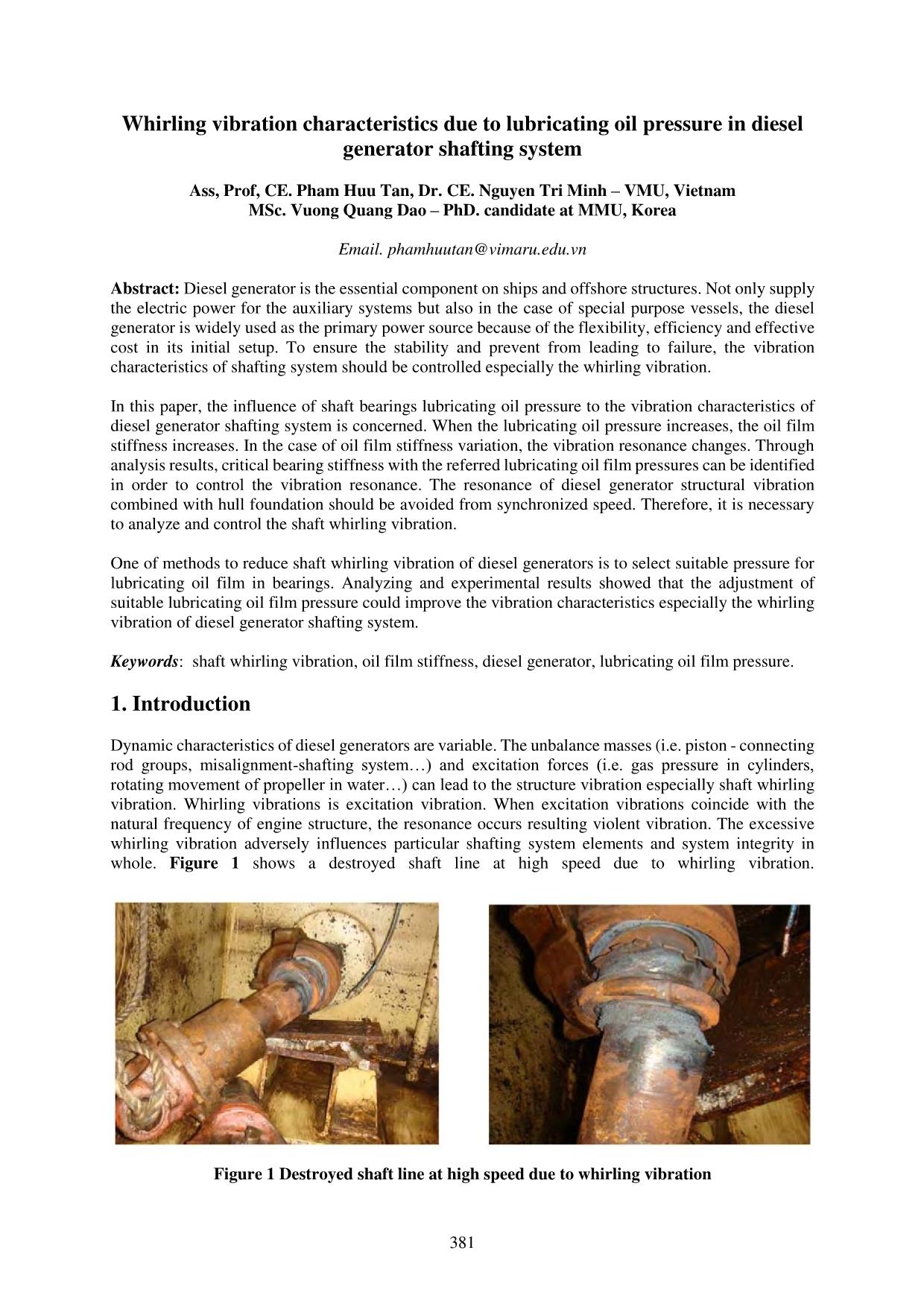
Trang 1
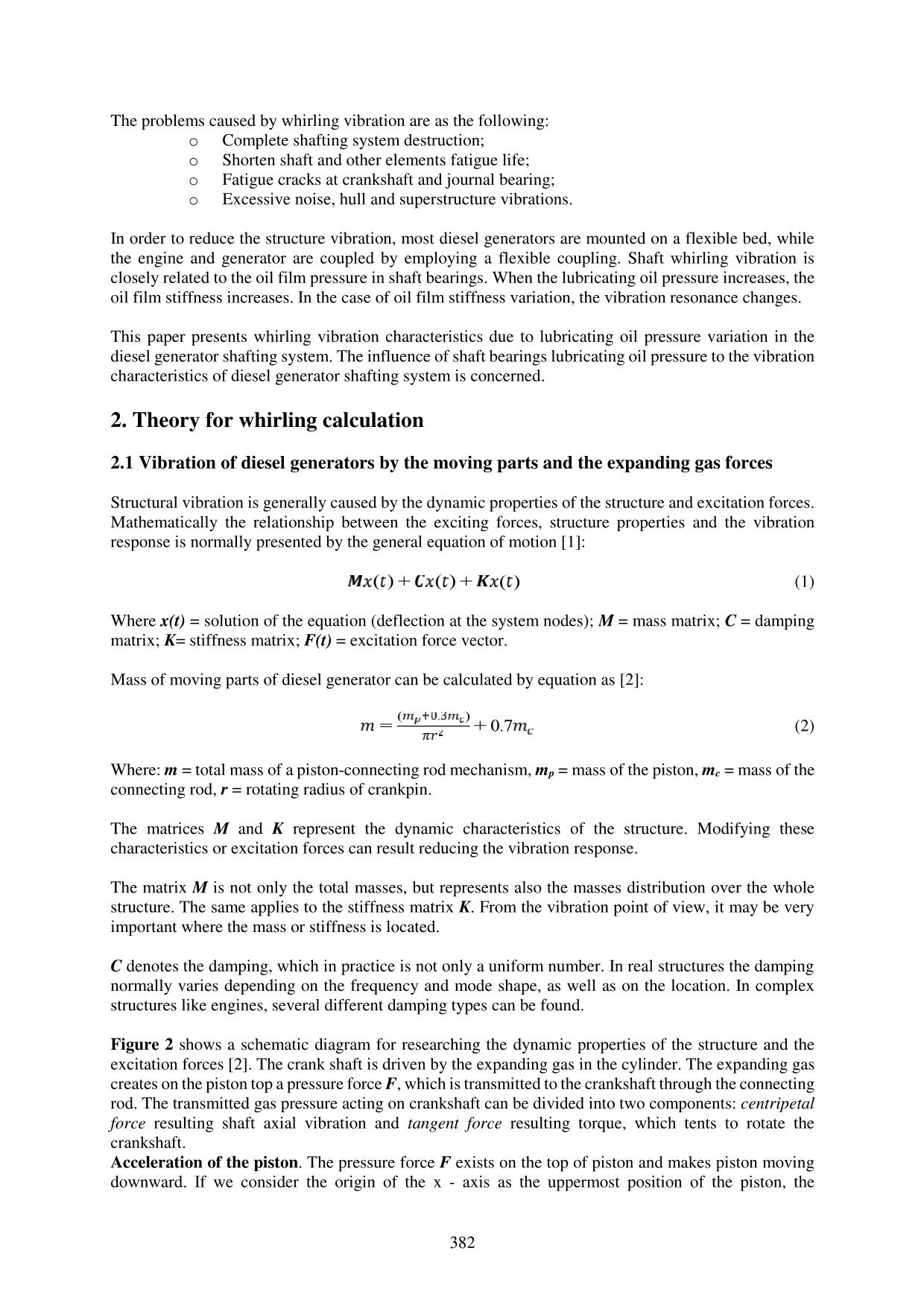
Trang 2
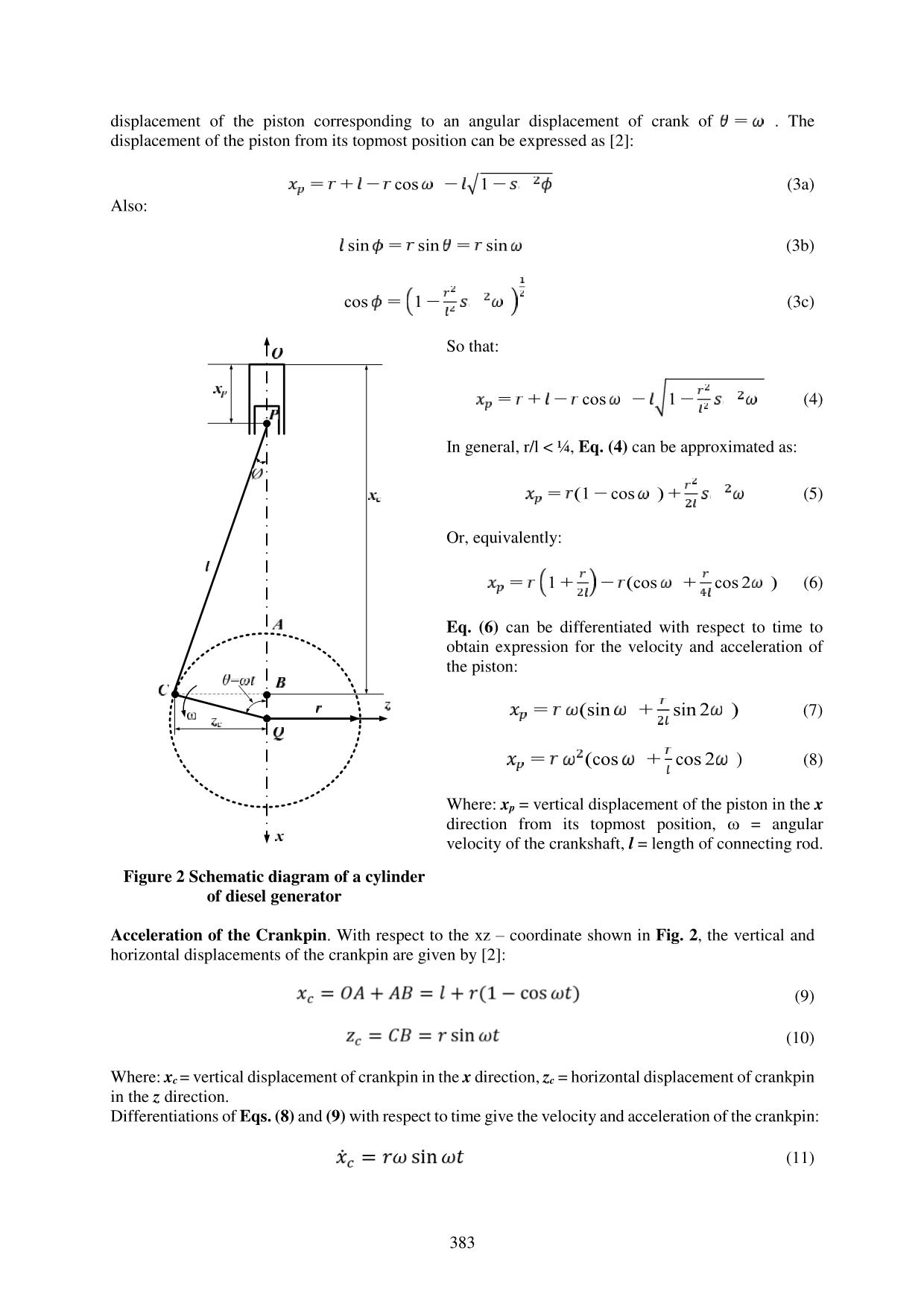
Trang 3
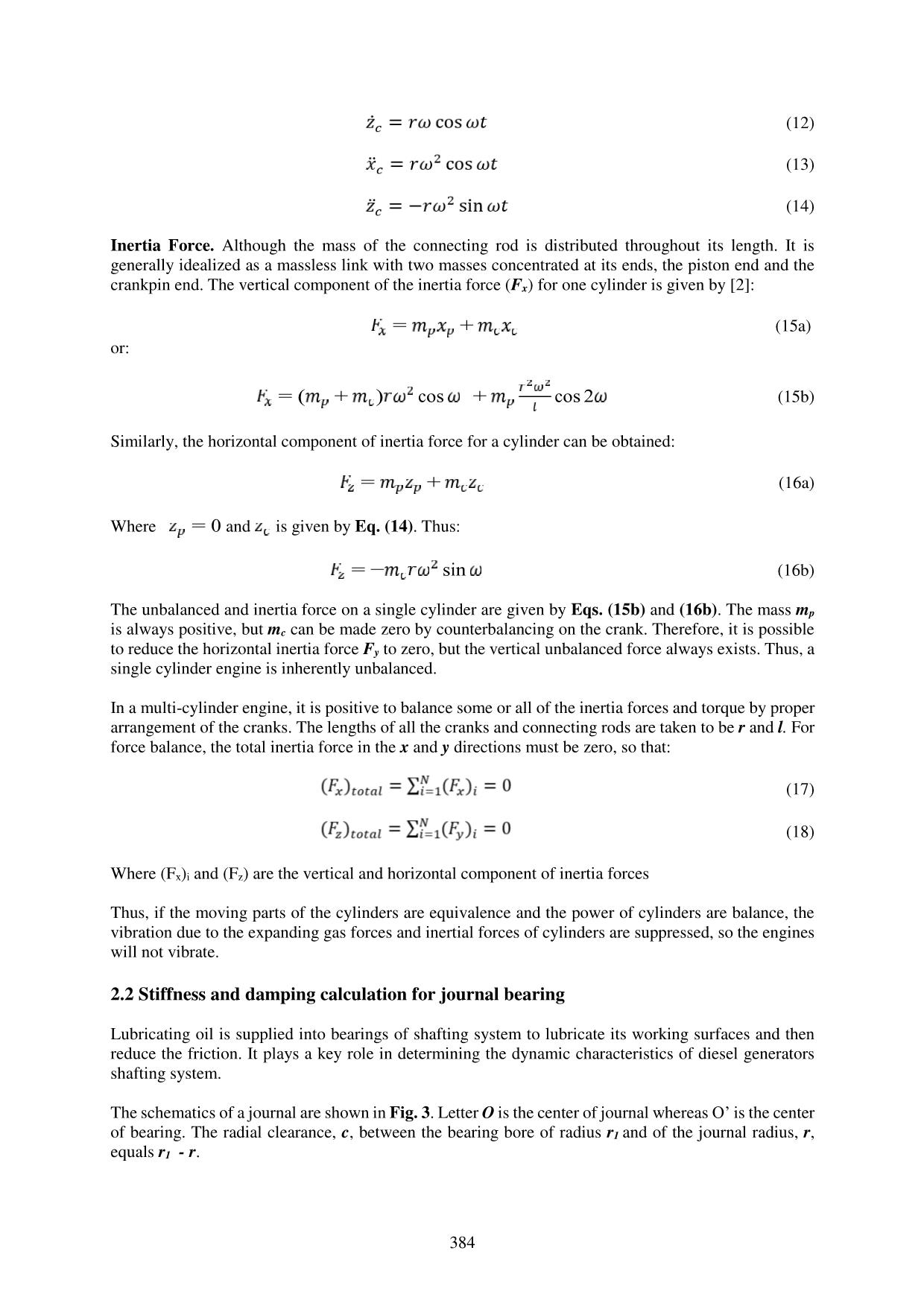
Trang 4
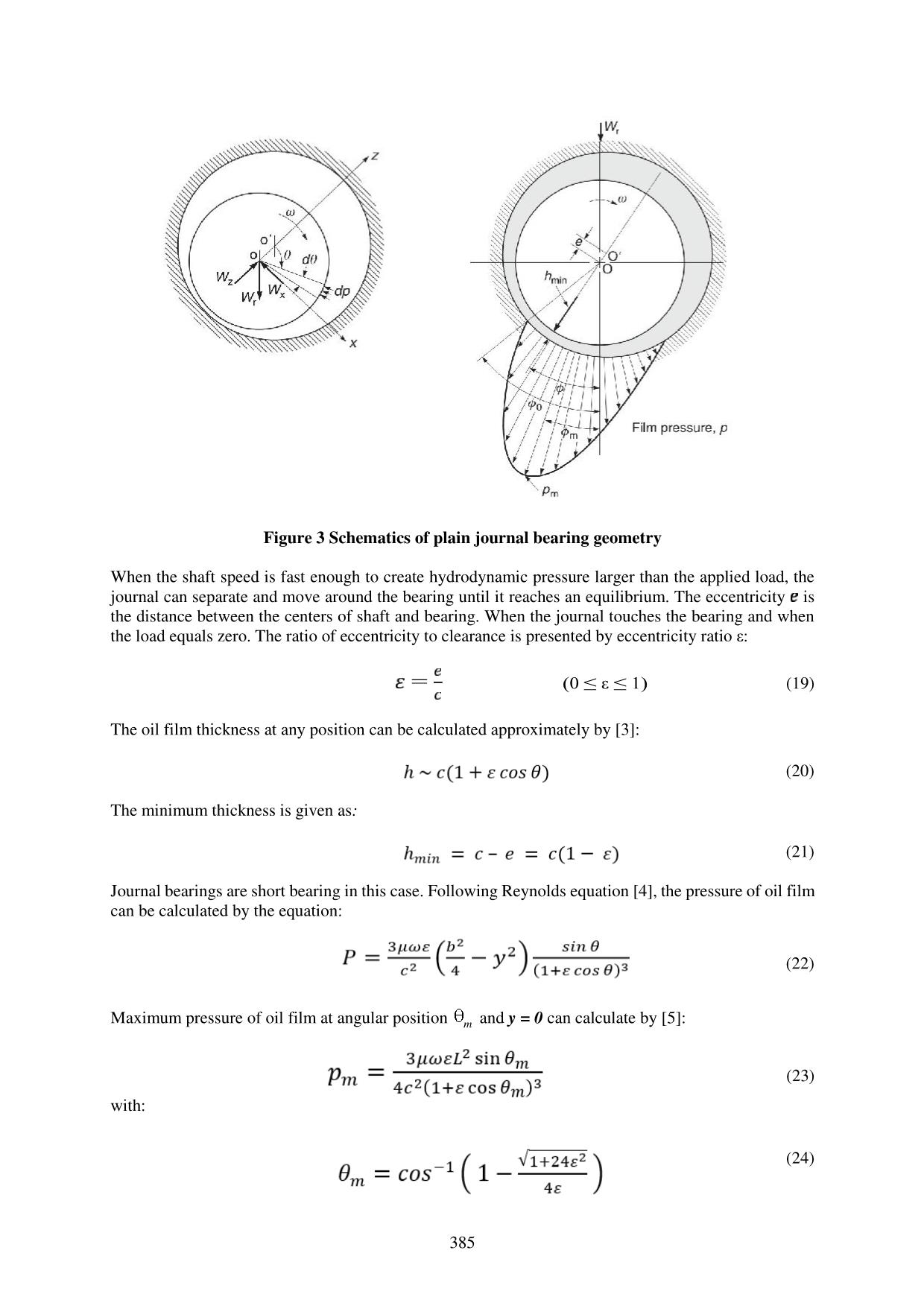
Trang 5
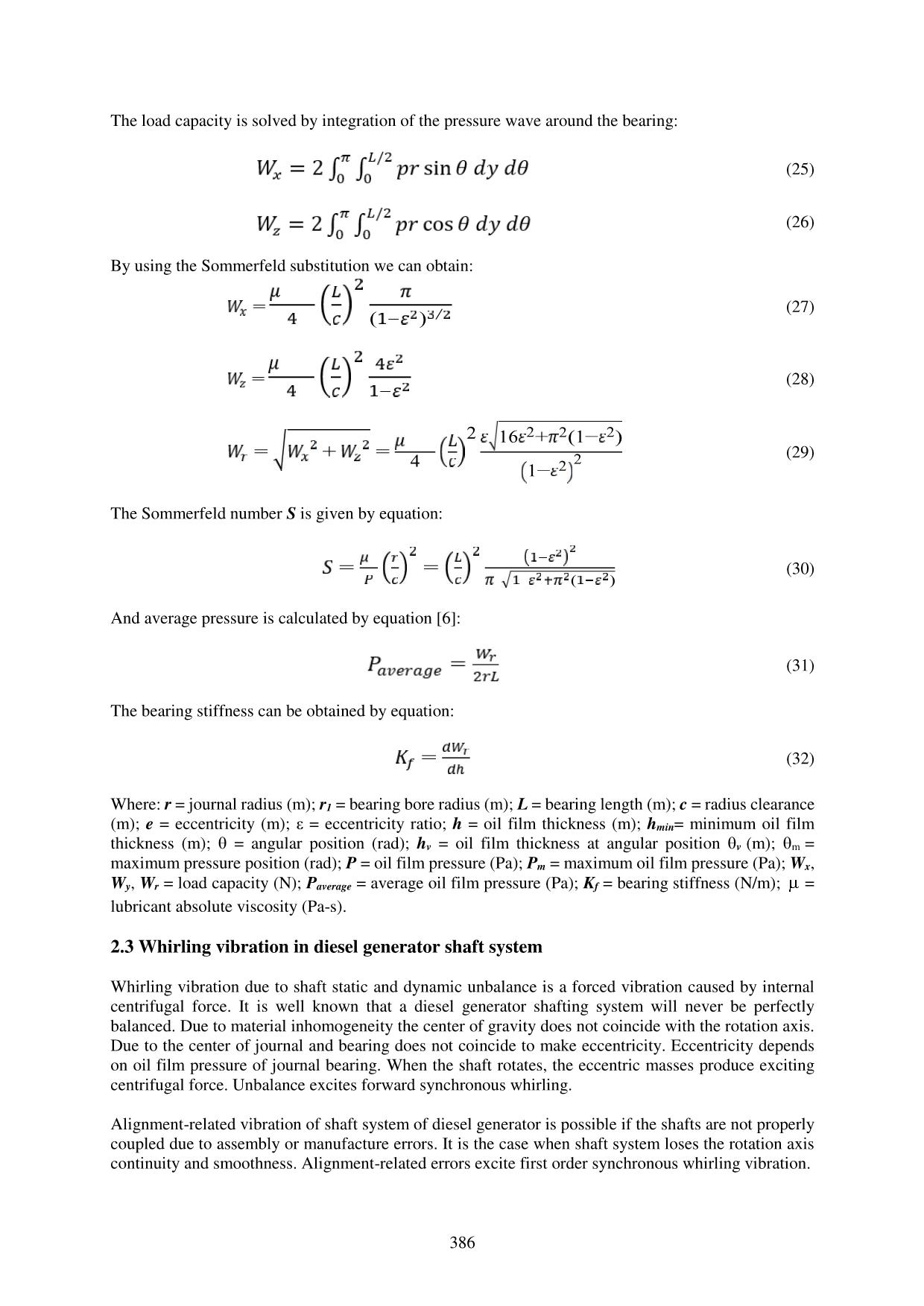
Trang 6
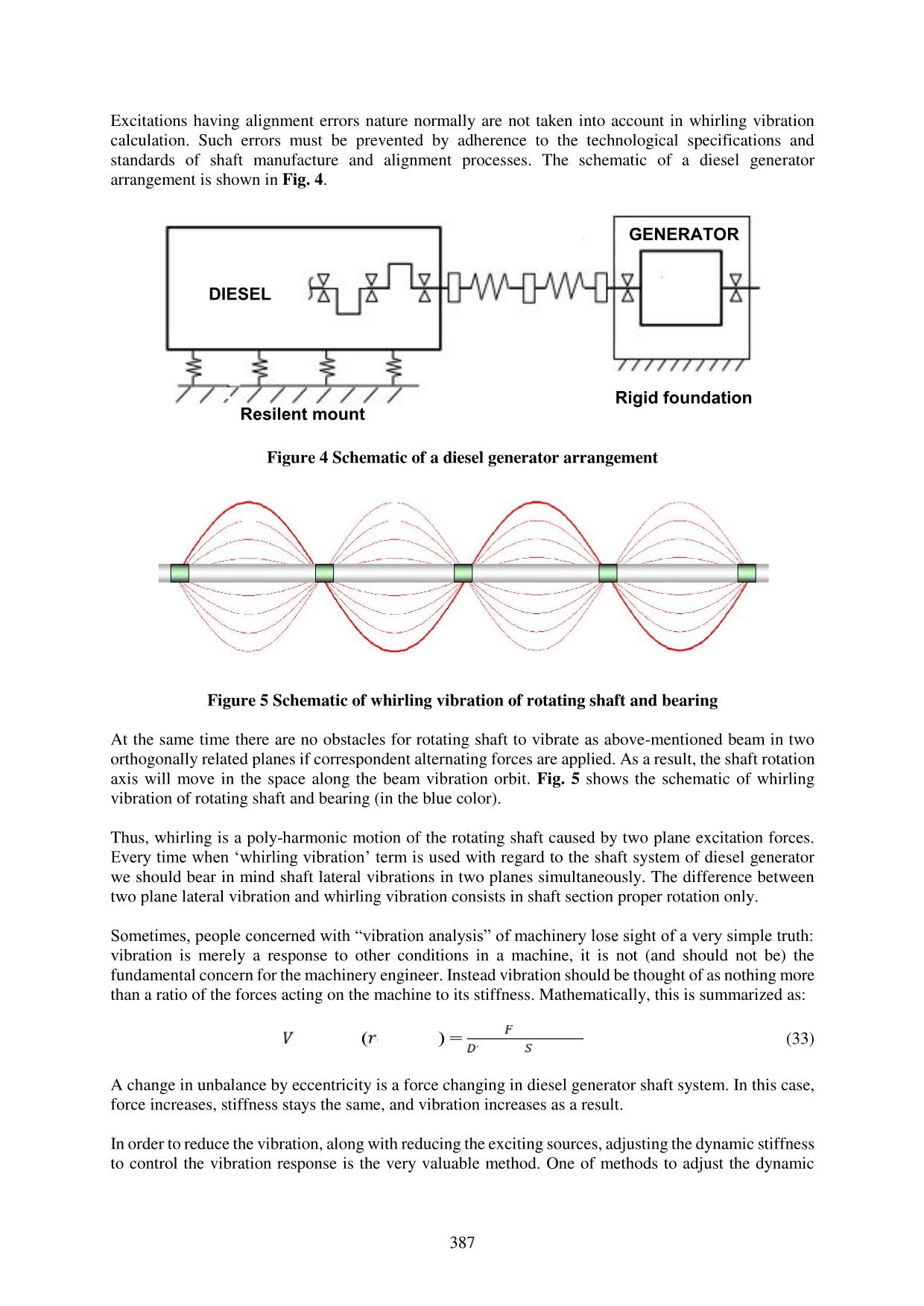
Trang 7
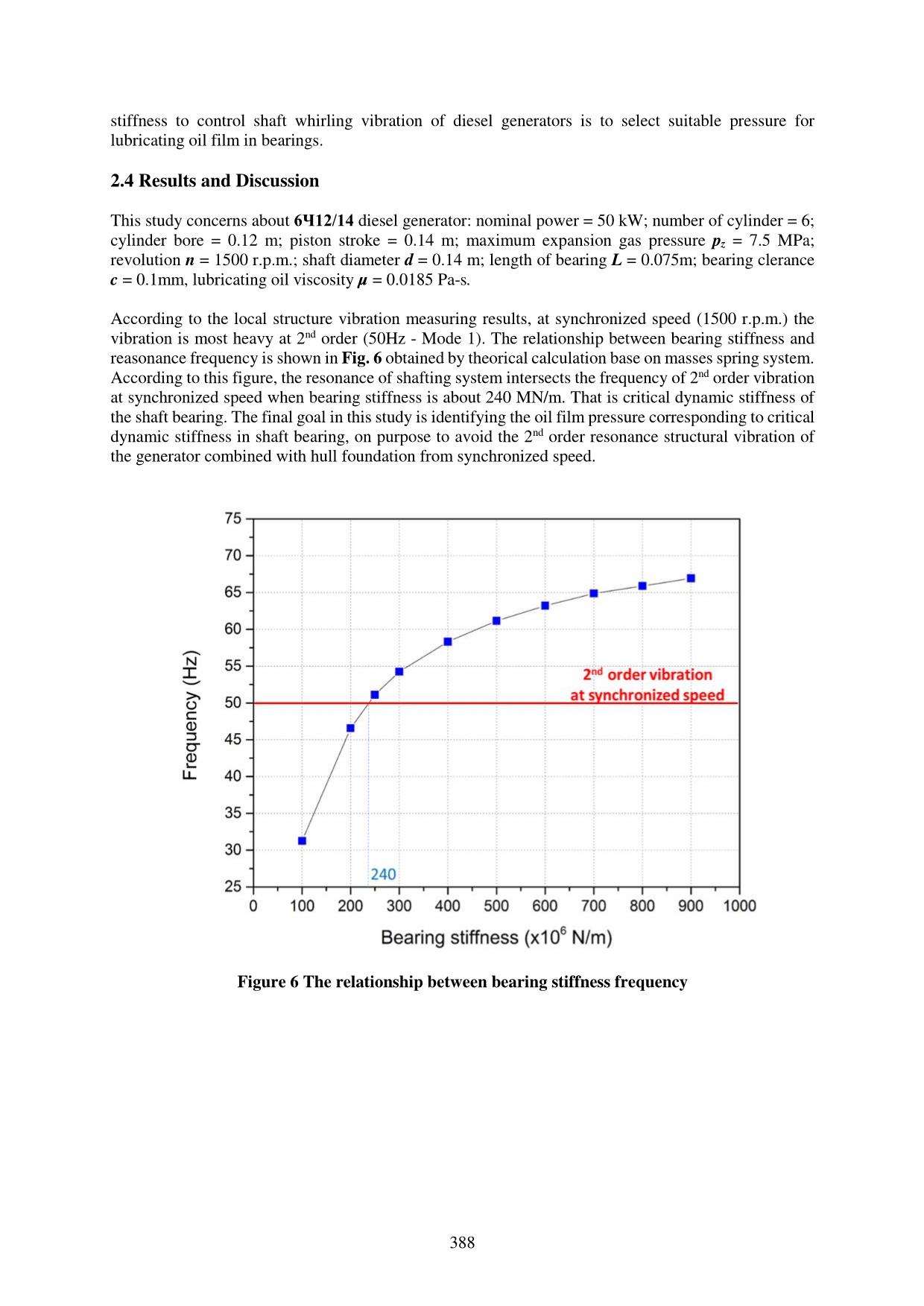
Trang 8
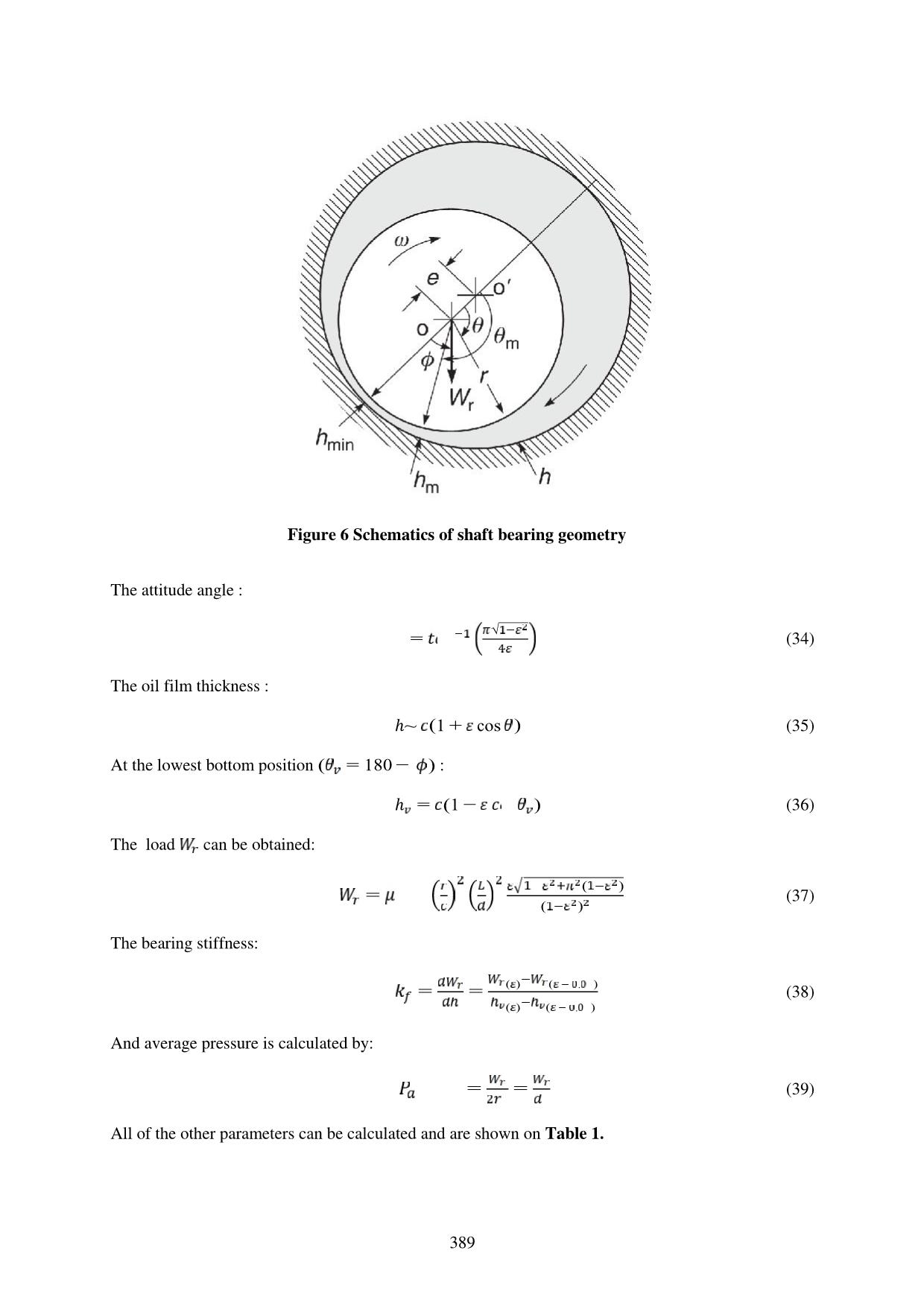
Trang 9
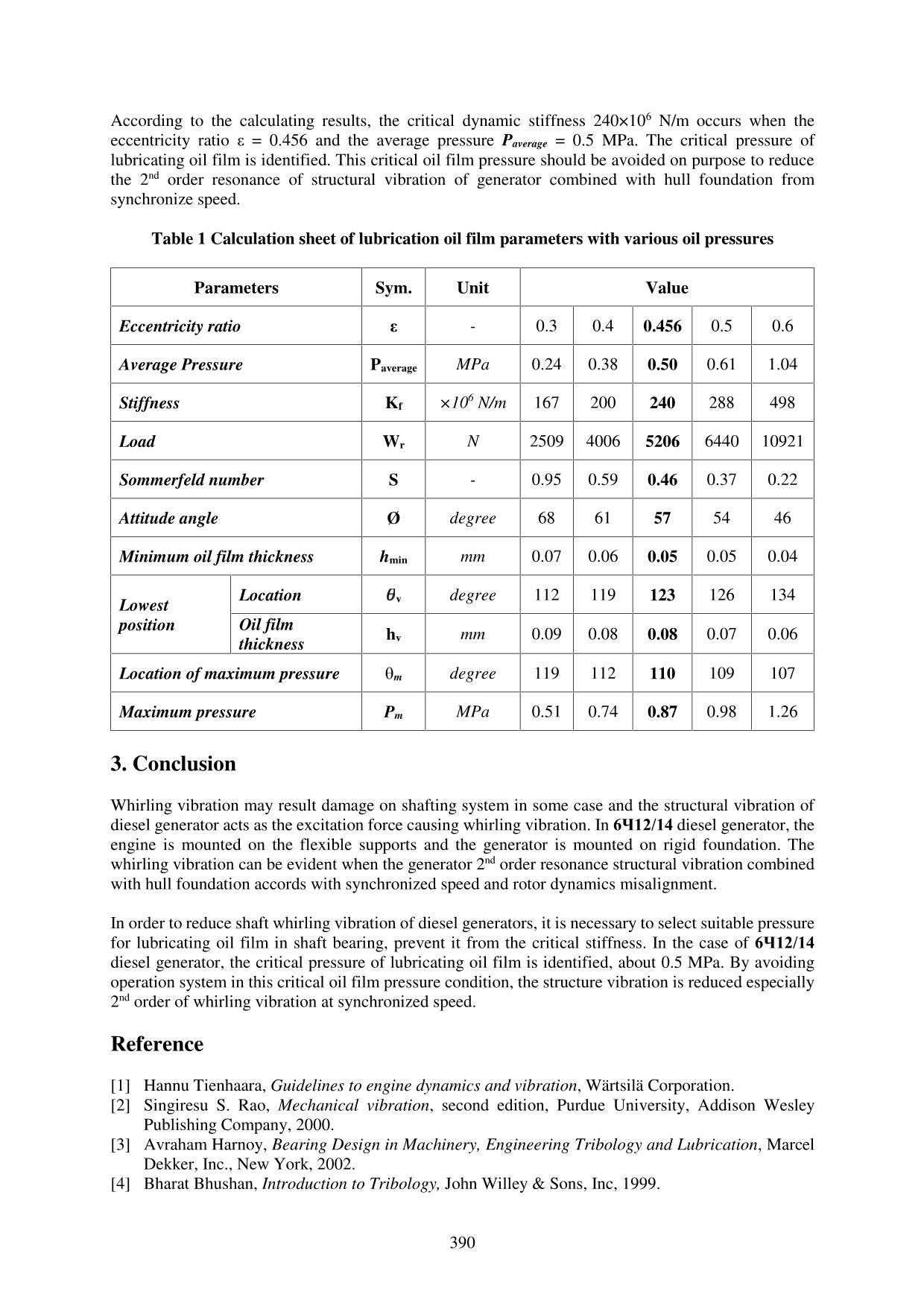
Trang 10
Tải về để xem bản đầy đủ
Tóm tắt nội dung tài liệu: Whirling vibration characteristics due to lubricating oil pressure in diesel generator shafting system
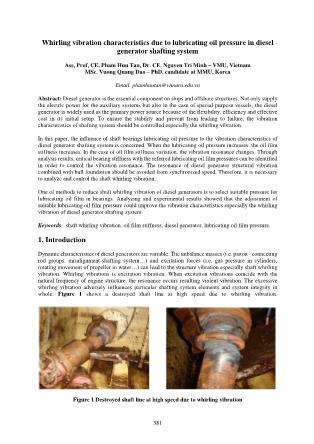
381 Whirling vibration characteristics due to lubricating oil pressure in diesel generator shafting system Ass, Prof, CE. Pham Huu Tan, Dr. CE. Nguyen Tri Minh – VMU, Vietnam MSc. Vuong Quang Dao – PhD. candidate at MMU, Korea Email. phamhuutan@vimaru.edu.vn Abstract: Diesel generator is the essential component on ships and offshore structures. Not only supply the electric power for the auxiliary systems but also in the case of special purpose vessels, the diesel generator is widely used as the primary power source because of the flexibility, efficiency and effective cost in its initial setup. To ensure the stability and prevent from leading to failure, the vibration characteristics of shafting system should be controlled especially the whirling vibration. In this paper, the influence of shaft bearings lubricating oil pressure to the vibration characteristics of diesel generator shafting system is concerned. When the lubricating oil pressure increases, the oil film stiffness increases. In the case of oil film stiffness variation, the vibration resonance changes. Through analysis results, critical bearing stiffness with the referred lubricating oil film pressures can be identified in order to control the vibration resonance. The resonance of diesel generator structural vibration combined with hull foundation should be avoided from synchronized speed. Therefore, it is necessary to analyze and control the shaft whirling vibration. One of methods to reduce shaft whirling vibration of diesel generators is to select suitable pressure for lubricating oil film in bearings. Analyzing and experimental results showed that the adjustment of suitable lubricating oil film pressure could improve the vibration characteristics especially the whirling vibration of diesel generator shafting system. Keywords: shaft whirling vibration, oil film stiffness, diesel generator, lubricating oil film pressure. 1. Introduction Dynamic characteristics of diesel generators are variable. The unbalance masses (i.e. piston - connecting rod groups, misalignment-shafting system) and excitation forces (i.e. gas pressure in cylinders, rotating movement of propeller in water) can lead to the structure vibration especially shaft whirling vibration. Whirling vibrations is excitation vibration. When excitation vibrations coincide with the natural frequency of engine structure, the resonance occurs resulting violent vibration. The excessive whirling vibration adversely influences particular shafting system elements and system integrity in whole. Figure 1 shows a destroyed shaft line at high speed due to whirling vibration. Figure 1 Destroyed shaft line at high speed due to whirling vibration 382 The problems caused by whirling vibration are as the following: o Complete shafting system destruction; o Shorten shaft and other elements fatigue life; o Fatigue cracks at crankshaft and journal bearing; o Excessive noise, hull and superstructure vibrations. In order to reduce the structure vibration, most diesel generators are mounted on a flexible bed, while the engine and generator are coupled by employing a flexible coupling. Shaft whirling vibration is closely related to the oil film pressure in shaft bearings. When the lubricating oil pressure increases, the oil film stiffness increases. In the case of oil film stiffness variation, the vibration resonance changes. This paper presents whirling vibration characteristics due to lubricating oil pressure variation in the diesel generator shafting system. The influence of shaft bearings lubricating oil pressure to the vibration characteristics of diesel generator shafting system is concerned. 2. Theory for whirling calculation 2.1 Vibration of diesel generators by the moving parts and the expanding gas forces Structural vibration is generally caused by the dynamic properties of the structure and excitation forces. Mathematically the relationship between the exciting forces, structure properties and the vibration response is normally presented by the general equation of motion [1]:̈ ( ) + ̇( ) + ( ) (1) Where x(t) = solution of the equation (deflection at the system nodes); M = mass matrix; C = damping matrix; K= stiffness matrix; F(t) = excitation force vector. Mass of moving parts of diesel generator can be calculated by equation as [2]:= ( . )+ 0.7 (2) Where: m = total mass of a piston-connecting rod mechanism, mp = mass of the piston, mc = mass of the connecting rod, r = rotating radius of crankpin. The matrices M and K represent the dynamic characteristics of the structure. Modifying these characteristics or excitation forces can result reducing the vibration response. The matrix M is not only the total masses, but represents also the masses distribution over the whole structure. The same applies to the stiffness matrix K. From the vibration point of view, it may be very important where the mass or stiffness is located. C denotes the damping, which in practice is not only a uniform number. In real structures the damping normally varies depending on the frequency and mode shape, as well as on the location. In complex structures like engines, several different damping types can be found. Figure 2 shows a schematic diagram for researching the dynamic properties of the structure and the excitation forces [2]. The crank shaft is driven by the expanding gas in the cylinder. The expanding gas creates on the piston top a pressure force F, which is transmitted to the crankshaft through the connecting rod. The transmitted gas pressure acting on crankshaft can be divided into two components: centripetal force resulting shaft axial vibration and tangent force resulting torque, which tents to rotate the crankshaft. Acceleration of the piston. The pressure force F exists on the top of piston and makes piston moving downward. If we consider the origin of the x - axis as the uppermost position of the piston, the 383 displacement of the piston corresponding to an angular displacement of crank of = . The displacement of the piston from its topmost position can be expressed as [2]:= + − cos − 1 − (3a) Also: sin = sin = sin (3b) cos = 1 − (3c) Figure 2 Schematic diagram of a cylinder of diesel generator So that: = + − cos − 1 − (4) In general, r/l < ¼, Eq. (4) can be approximated as:= (1 − cos ) + (5) Or, equivalently:= 1 + − (cos + cos 2 ) (6) Eq. (6) can be differentiated with respect to time to obtain expression for the velocity and acceleration of the piston:̇ = (sin + sin 2 ) (7)̈ = (cos + cos 2 ) (8) Where: xp = vertical displacement of the piston in the x direction from its topmost position, ω = angular velocity of the crankshaft, l = length of connecting rod. Acceleration of the Crankpin. With respect to the xz – coordinate shown in Fig. 2, the vertical and horizontal displacements of the crankpin are given by [2]:= + = + (1 − cos ) (9)= = sin (10) Where: xc = vertical displacement of crankpin in the x direction, zc = horizontal displacement of crankpin in the z direction. Differentiations of Eqs. (8) and (9) with respect to time give the velocity and acceleration of the crankpin:̇ = sin (11) 384 ̇ = cos (12)̈ = cos (13)̈ = − sin (14) Inertia Force. Although the mass of the connecting rod is distributed throughout its length. It is generally idealized as a massless link with two masses concentrated at its ends, the piston end and the crankpin end. The vertical component of the inertia force (Fx) for one cylinder is given by [2]:= ̈ + ̈ (15a) or: = ( + ) cos + cos 2 (15b) Similarly, the horizontal component of inertia force for a cylinder can be obtained:= ̈ + ̈ (16a) Where ̈ = 0 and ̈ is given by Eq. (14). Thus:= − sin (16b) The unbalanced and inertia force on a single cylinder are given by Eqs. (15b) and (16b). The mass mp is always positive, but mc can be made zero by counterbalancing on the crank. Therefore, it is possible to reduce the horizontal inertia force Fy to zero, but the vertical unbalanced force always exists. Thus, a single cylinder engine is inherently unbalanced. In a multi-cylinder engine, it is positive to balance some or all of the inertia forces and torque by proper arrangement of the cranks. The lengths of all the cranks and connecting rods are taken to be r and l. For force balance, the total inertia force in the x and y directions must be zero, so that:( ) = ∑ ( ) = 0 (17)( ) = ∑ ( ) = 0 (18) Where (Fx)i and (Fz) are the vertical and horizontal component of inertia forces Thus, if the moving parts of the cylinders are equivalence and the power of cylinders are balance, the vibration due to the expanding gas forces and inertial forces of cylinders are suppressed, so the engines will not vibrate. 2.2 Stiffness and damping calculation for journal bearing Lubricating oil is supplied into bearings of shafting system to lubricate its working surfaces and then reduce the friction. It plays a key role in determining the dynamic characteristics of diesel generators shafting system. The schematics of a journal are shown in Fig. 3. Letter O is the center of journal whereas O’ is the center of bearing. The radial clearance, c, between the bearing bore of radius r1 and of the journal radius, r, equals r1 - r. 385 Figure 3 Schematics of plain journal bearing geometry When the shaft speed is fast enough to create hydrodynamic pressure larger than the applied load, the journal can separate and move around the bearing until it reaches an equilibrium. The eccentricity is the distance between the centers of shaft and bearing. When the journal touches the bearing and when the load equals zero. The ratio of eccentricity to clearance is presented by eccentricity ratio ε:= (0 ≤ ε ≤ 1) (19) The oil film thickness at any position can be calculated approximately by [3]:ℎ ~ (1 + ) (20) The minimum thickness is given as: ℎ = – = (1 − ) (21) Journal bearings are short bearing in this case. Following Reynolds equation [4], the pressure of oil film can be calculated by the equation: = − ( ) (22) Maximum pressure of oil film at angular position m and y = 0 can calculate by [5]:= ( ) (23) with: = 1 − √ (24) 386 The load capacity is solved by integration of the pressure wave around the bearing:= 2∫ ∫ sin/ (25)= 2∫ ∫ cos/ (26) By using the Sommerfeld substitution we can obtain:= ( ) / (27) = (28) = + = 4 2 16 2+ 2(1− 2)1− 2 2 (29) The Sommerfeld number S is given by equation:= = ( ) (30) And average pressure is calculated by equation [6]:= (31) The bearing stiffness can be obtained by equation:= (32) Where: r = journal radius (m); r1 = bearing bore radius (m); L = bearing length (m); c = radius clearance (m); e = eccentricity (m); ε = eccentricity ratio; h = oil film thickness (m); hmin= minimum oil film thickness (m); θ = angular position (rad); hv = oil film thickness at angular position θv (m); θm = maximum pressure position (rad); P = oil film pressure (Pa); Pm = maximum oil film pressure (Pa); Wx, Wy, Wr = load capacity (N); Paverage = average oil film pressure (Pa); Kf = bearing stiffness (N/m); = lubricant absolute viscosity (Pa-s). 2.3 Whirling vibration in diesel generator shaft system Whirling vibration due to shaft static and dynamic unbalance is a forced vibration caused by internal centrifugal force. It is well known that a diesel generator shafting system will never be perfectly balanced. Due to material inhomogeneity the center of gravity does not coincide with the rotation axis. Due to the center of journal and bearing does not coincide to make eccentricity. Eccentricity depends on oil film pressure of journal bearing. When the shaft rotates, the eccentric masses produce exciting centrifugal force. Unbalance excites forward synchronous whirling. Alignment-related vibration of shaft system of diesel generator is possible if the shafts are not properly coupled due to assembly or manufacture errors. It is the case when shaft system loses the rotation axis continuity and smoothness. Alignment-related errors excite first order synchronous whirling vibration. 387 Excitations having alignment errors nature normally are not taken into account in whirling vibration calculation. Such errors must be prevented by adherence to the technological specifications and standards of shaft manufacture and alignment processes. The schematic of a diesel generator arrangement is shown in Fig. 4. Figure 4 Schematic of a diesel generator arrangement Figure 5 Schematic of whirling vibration of rotating shaft and bearing At the same time there are no obstacles for rotating shaft to vibrate as above-mentioned beam in two orthogonally related planes if correspondent alternating forces are applied. As a result, the shaft rotation axis will move in the space along the beam vibration orbit. Fig. 5 shows the schematic of whirling vibration of rotating shaft and bearing (in the blue color). Thus, whirling is a poly-harmonic motion of the rotating shaft caused by two plane excitation forces. Every time when ‘whirling vibration’ term is used with regard to the shaft system of diesel generator we should bear in mind shaft lateral vibrations in two planes simultaneously. The difference between two plane lateral vibration and whirling vibration consists in shaft section proper rotation only. Sometimes, people concerned with “vibration analysis” of machinery lose sight of a very simple truth: vibration is merely a response to other conditions in a machine, it is not (and should not be) the fundamental concern for the machinery engineer. Instead vibration should be thought of as nothing more than a ratio of the forces acting on the machine to its stiffness. Mathematically, this is summarized as:( ) = (33) A change in unbalance by eccentricity is a force changing in diesel generator shaft system. In this case, force increases, stiffness stays the same, and vibration increases as a result. In order to reduce the vibration, along with reducing the exciting sources, adjusting the dynamic stiffness to control the vibration response is the very valuable method. One of methods to adjust the dynamic DIESEL GENERATOR Rigid foundation Resilent mount 388 stiffness to control shaft whirling vibration of diesel generators is to select suitable pressure for lubricating oil film in bearings. 2.4 Results and Discussion This study concerns about 6Ч12/14 diesel generator: nominal power = 50 kW; number of cylinder = 6; cylinder bore = 0.12 m; piston stroke = 0.14 m; maximum expansion gas pressure pz = 7.5 MPa; revolution n = 1500 r.p.m.; shaft diameter d = 0.14 m; length of bearing L = 0.075m; bearing clerance c = 0.1mm, lubricating oil viscosity µ = 0.0185 Pa-s. According to the local structure vibration measuring results, at synchronized speed (1500 r.p.m.) the vibration is most heavy at 2nd order (50Hz - Mode 1). The relationship between bearing stiffness and reasonance frequency is shown in Fig. 6 obtained by theorical calculation base on masses spring system. According to this figure, the resonance of shafting system intersects the frequency of 2nd order vibration at synchronized speed when bearing stiffness is about 240 MN/m. That is critical dynamic stiffness of the shaft bearing. The final goal in this study is identifying the oil film pressure corresponding to critical dynamic stiffness in shaft bearing, on purpose to avoid the 2nd order resonance structural vibration of the generator combined with hull foundation from synchronized speed. Figure 6 The relationship between bearing stiffness frequency 389 The attitude angle : ∅ = √ (34) The oil film thickness : ℎ~ (1 + cos ) (35) At the lowest bottom position ( = 180 − ) :ℎ = (1 − ) (36) The load can be obtained: = ( )( ) (37) The bearing stiffness: = = ( ) ( . )( ) ( . ) (38) And average pressure is calculated by: = = (39) All of the other parameters can be calculated and are shown on Table 1. Figure 6 Schematics of shaft bearing geometry 390 According to the calculating results, the critical dynamic stiffness 240×106 N/m occurs when the eccentricity ratio ε = 0.456 and the average pressure Paverage = 0.5 MPa. The critical pressure of lubricating oil film is identified. This critical oil film pressure should be avoided on purpose to reduce the 2nd order resonance of structural vibration of generator combined with hull foundation from synchronize speed. Table 1 Calculation sheet of lubrication oil film parameters with various oil pressures Parameters Sym. Unit Value Eccentricity ratio ε - 0.3 0.4 0.456 0.5 0.6 Average Pressure Paverage MPa 0.24 0.38 0.50 0.61 1.04 Stiffness Kf ×106 N/m 167 200 240 288 498 Load Wr N 2509 4006 5206 6440 10921 Sommerfeld number S - 0.95 0.59 0.46 0.37 0.22 Attitude angle Ø degree 68 61 57 54 46 Minimum oil film thickness hmin mm 0.07 0.06 0.05 0.05 0.04 Lowest position Location v degree 112 119 123 126 134 Oil film thickness hv mm 0.09 0.08 0.08 0.07 0.06 Location of maximum pressure θm degree 119 112 110 109 107 Maximum pressure Pm MPa 0.51 0.74 0.87 0.98 1.26 3. Conclusion Whirling vibration may result damage on shafting system in some case and the structural vibration of diesel generator acts as the excitation force causing whirling vibration. In 6Ч12/14 diesel generator, the engine is mounted on the flexible supports and the generator is mounted on rigid foundation. The whirling vibration can be evident when the generator 2nd order resonance structural vibration combined with hull foundation accords with synchronized speed and rotor dynamics misalignment. In order to reduce shaft whirling vibration of diesel generators, it is necessary to select suitable pressure for lubricating oil film in shaft bearing, prevent it from the critical stiffness. In the case of 6Ч12/14 diesel generator, the critical pressure of lubricating oil film is identified, about 0.5 MPa. By avoiding operation system in this critical oil film pressure condition, the structure vibration is reduced especially 2nd order of whirling vibration at synchronized speed. Reference [1] Hannu Tienhaara, Guidelines to engine dynamics and vibration, Wärtsilä Corporation. [2] Singiresu S. Rao, Mechanical vibration, second edition, Purdue University, Addison Wesley Publishing Company, 2000. [3] Avraham Harnoy, Bearing Design in Machinery, Engineering Tribology and Lubrication, Marcel Dekker, Inc., New York, 2002. [4] Bharat Bhushan, Introduction to Tribology, John Willey & Sons, Inc, 1999. 391 [5] Fouad Y. Zeidan and Bernard S. Herbage, Fluid film bearing fundamentals and failure analysis, TAMU Turbo Show, 1991 [6] Bernard J. Hamrock, Steven R. Schmid, and Bo O. Jacobson, Fundamentals of Fluid Film Lubrication, second edition, Marcel Dekker, Inc., New York, 2004. [7] ORBIT Second Quarter 2000, Understanding and Using Dynamic, ORBIT Magazine, 2000.
File đính kèm:
 whirling_vibration_characteristics_due_to_lubricating_oil_pr.pdf
whirling_vibration_characteristics_due_to_lubricating_oil_pr.pdf

